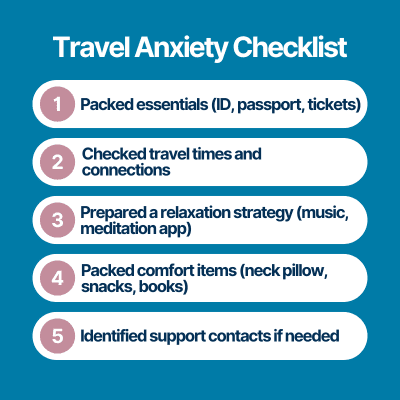Travel can be exciting, but for many people, the thought of getting on a plane, navigating airports, or even packing a bag brings on overwhelming stress.
These are known as travel anxiety symptoms, and they can affect both seasoned travelers and first-timers alike. From physical sensations like nausea and a racing heart to behaviors like obsessive planning or avoiding trips altogether, travel anxiety can steal the joy from what should be a positive experience.
In this blog, we’ll break down the most common travel anxiety symptoms, explore what causes them, explain how travel anxiety differs from general anxiety, and highlight coping strategies—including therapy—that can help you manage your stress before and during your journey.
What are the symptoms of travel anxiety?

Travel anxiety symptoms vary from person to person, but they often fall into physical, emotional, and behavioral categories. Common symptoms include:
-
Physical: nausea, sweating, racing heart, stomach upset, muscle tension, or shortness of breath.
-
Emotional: dread, irritability, excessive fear, or restlessness.
-
Cognitive: obsessive planning, catastrophic thoughts (“What if the plane crashes?”), or constant worry about things going wrong.
-
Behavioral: avoidance of trips, overpacking, repeatedly checking tickets or documents, or seeking constant reassurance.
These symptoms can appear days before departure, intensify during travel, and sometimes linger until you return home.
What causes anxiety before or during travel?
Several factors contribute to travel anxiety, and often they overlap:
-
Fear of the unknown: New environments, airports, or foreign languages can feel overwhelming.
-
Loss of control: Relying on pilots, schedules, or transportation systems can trigger stress.
-
Past negative experiences: Bad turbulence, missed flights, or lost luggage can leave lasting fear.
-
Social or performance pressure: Traveling with others or being away from familiar routines may feel stressful.
-
Existing anxiety disorders: People with generalized anxiety or panic disorders often find their symptoms magnified while traveling.
Understanding these causes helps you recognize what’s fueling your travel anxiety symptoms and gives you a starting point for addressing them.
How is travel anxiety different from general anxiety?
While travel anxiety shares similarities with generalized anxiety disorder (GAD), there are key differences:
-
General anxiety: Worries are broad and ongoing, covering work, finances, relationships, and everyday stressors.
-
Travel anxiety: Symptoms are situational, triggered specifically by preparing for, engaging in, or reflecting on travel experiences.
For example, someone who generally functions well might only experience heightened anxiety when booking a flight or boarding a plane. Understanding this distinction is important because it allows for tailored coping strategies that address the travel-specific triggers rather than general life stress.
Can therapy help with travel-related anxiety?
Yes. Therapy can be extremely effective in reducing travel anxiety symptoms and preventing avoidance behaviors. Common approaches include:
-
Cognitive Behavioral Therapy (CBT): Identifies unhelpful thought patterns (“I know the plane will crash”) and reframes them with realistic perspectives.
-
Exposure therapy: Gradually desensitizes fear by practicing with small steps, such as watching videos of flights or visiting an airport without boarding.
-
Mindfulness and relaxation techniques: Helps calm the body’s physical response to stress through breathing exercises, meditation, or grounding strategies.
-
Medication: In some cases, a doctor may recommend short-term medication for high-anxiety situations like long flights.
Therapy empowers individuals not only to manage travel anxiety symptoms but also to enjoy trips with more confidence and peace of mind.
What coping strategies work for travel anxiety?
Even without therapy, there are many practical tools you can use to manage travel anxiety symptoms:
-
Prepare with a checklist: Create a simple, repeatable list to reduce overthinking.
-
Practice grounding techniques: Use the 5-4-3-2-1 method to stay in the moment during stressful times.
-
Limit caffeine and alcohol: Both can increase heart rate and worsen feelings of anxiety.
-
Build comfort into the trip: Bring headphones, a book, or calming apps to distract and relax.
-
Break travel into steps: Focus on one part of the journey (packing, checking in, boarding) instead of the entire trip at once.
-
Progressive muscle relaxation: Tense and release muscles to calm your body during flights or long drives.
-
Stay connected: Share your itinerary with a friend or family member for reassurance.
Chart: Anxiety Severity Levels During Travel Phases
| Travel Phase | Mild Anxiety (manageable) | Moderate Anxiety (disruptive) | Severe Anxiety (overwhelming) |
|---|---|---|---|
| Before travel | Restlessness, butterflies | Trouble sleeping, overpacking | Panic attacks, trip avoidance |
| During travel | Nervous energy, fidgeting | Racing heart, nausea | Intense fear, dissociation |
| Arrival & stay | Adjustment stress | Worry about safety or logistics | Isolation, refusal to leave hotel |
Conclusion
Travel anxiety symptoms are more common than you might think—and they don’t have to define your travel experience. By learning to recognize symptoms, understanding what causes them, and using therapy or coping strategies, you can reduce fear and build confidence in your ability to manage travel stress.
With the right tools, it’s possible to move from anxiety to excitement and truly enjoy your next journey.
Ready to start your growth journey?
info@cookcounselingandconsulting.com
Phone
(614) 835 6068
follow us
Address
Pataskala Location
131 Oak Meadow Dr. Suite 105
Pataskala, OH 43062
Gahanna Location
800 Cross Pointe Road, Suite 800D,
Gahanna, OH 43230

